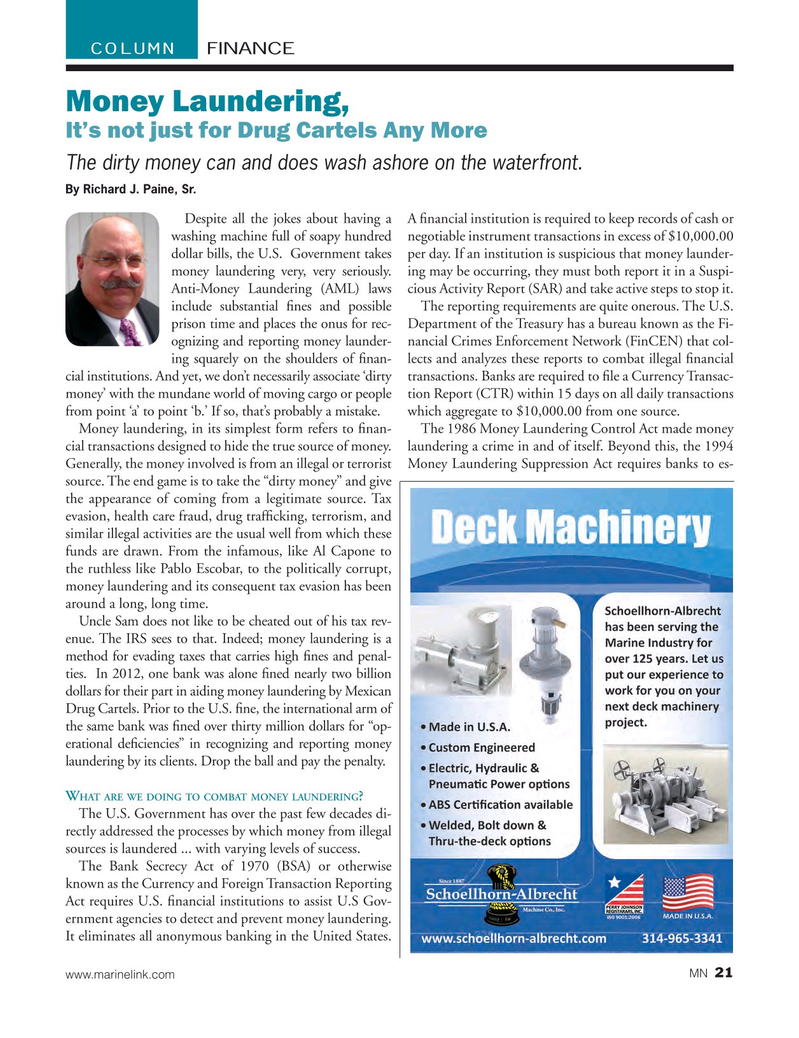
Page 21: of Marine News Magazine (July 2015)
Propulsion Technology
Read this page in Pdf, Flash or Html5 edition of July 2015 Marine News Magazine
COLUMN FINANCE
Money Laundering,
It’s not just for Drug Cartels Any More
The dirty money can and does wash ashore on the waterfront.
By Richard J. Paine, Sr.
Despite all the jokes about having a A ? nancial institution is required to keep records of cash or washing machine full of soapy hundred negotiable instrument transactions in excess of $10,000.00 dollar bills, the U.S. Government takes per day. If an institution is suspicious that money launder- money laundering very, very seriously. ing may be occurring, they must both report it in a Suspi-
Anti-Money Laundering (AML) laws cious Activity Report (SAR) and take active steps to stop it.
include substantial ? nes and possible The reporting requirements are quite onerous. The U.S. prison time and places the onus for rec- Department of the Treasury has a bureau known as the Fi- ognizing and reporting money launder- nancial Crimes Enforcement Network (FinCEN) that col- ing squarely on the shoulders of ? nan- lects and analyzes these reports to combat illegal ? nancial cial institutions. And yet, we don’t necessarily associate ‘dirty transactions. Banks are required to ? le a Currency Transac- money’ with the mundane world of moving cargo or people tion Report (CTR) within 15 days on all daily transactions from point ‘a’ to point ‘b.’ If so, that’s probably a mistake. which aggregate to $10,000.00 from one source.
Money laundering, in its simplest form refers to ? nan- The 1986 Money Laundering Control Act made money cial transactions designed to hide the true source of money. laundering a crime in and of itself. Beyond this, the 1994
Generally, the money involved is from an illegal or terrorist Money Laundering Suppression Act requires banks to es- source. The end game is to take the “dirty money” and give the appearance of coming from a legitimate source. Tax evasion, health care fraud, drug traf? cking, terrorism, and similar illegal activities are the usual well from which these funds are drawn. From the infamous, like Al Capone to the ruthless like Pablo Escobar, to the politically corrupt, money laundering and its consequent tax evasion has been around a long, long time.
Uncle Sam does not like to be cheated out of his tax rev- enue. The IRS sees to that. Indeed; money laundering is a method for evading taxes that carries high ? nes and penal- ties. In 2012, one bank was alone ? ned nearly two billion dollars for their part in aiding money laundering by Mexican
Drug Cartels. Prior to the U.S. ? ne, the international arm of the same bank was ? ned over thirty million dollars for “op- erational de? ciencies” in recognizing and reporting money laundering by its clients. Drop the ball and pay the penalty.
W ?
HAT ARE WE DOING TO COMBAT MONEY LAUNDERING
The U.S. Government has over the past few decades di- rectly addressed the processes by which money from illegal sources is laundered ... with varying levels of success.
The Bank Secrecy Act of 1970 (BSA) or otherwise known as the Currency and Foreign Transaction Reporting
Act requires U.S. ? nancial institutions to assist U.S Gov- ernment agencies to detect and prevent money laundering.
It eliminates all anonymous banking in the United States. 21
MN www.marinelink.com

 20
20

 22
22
